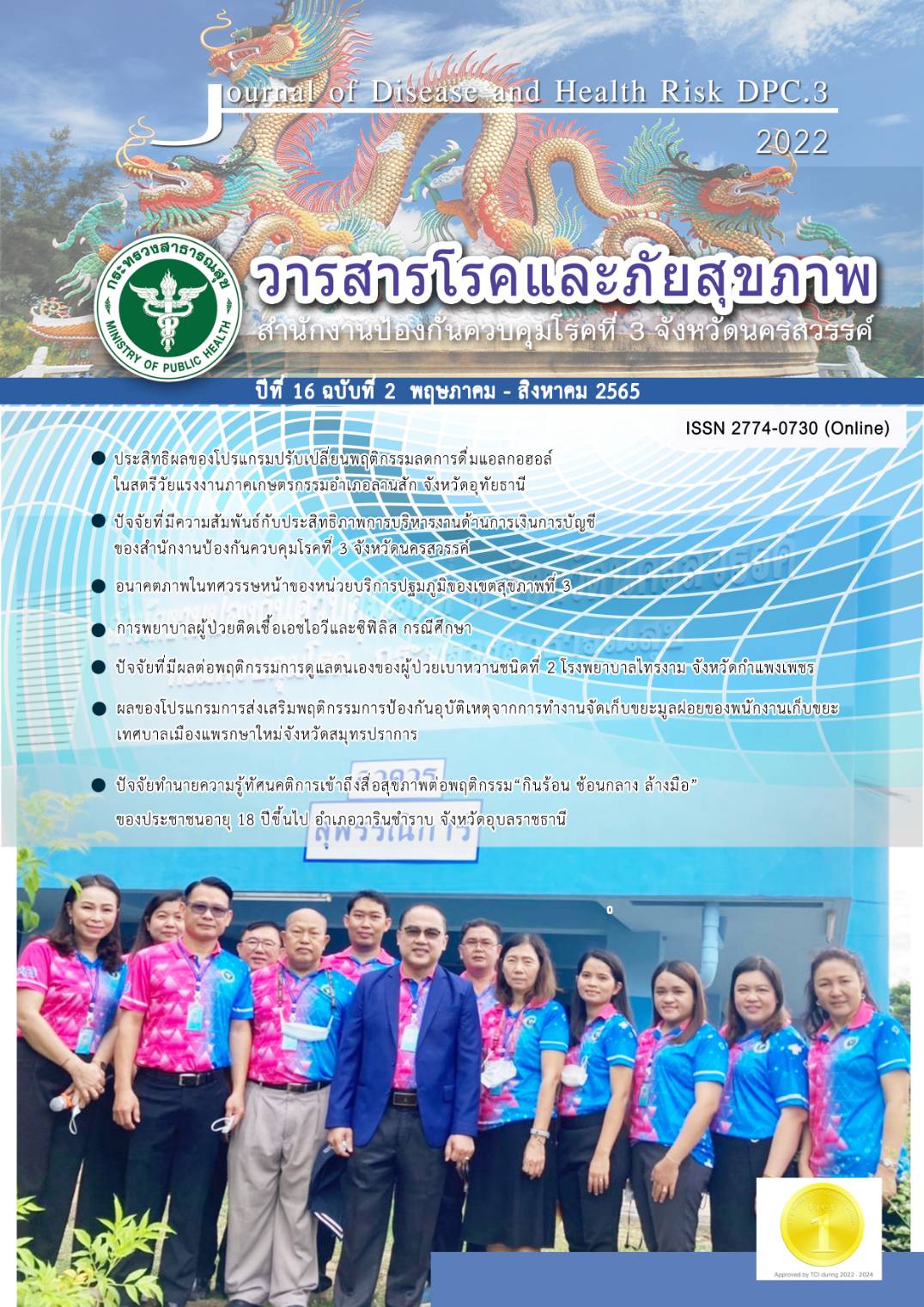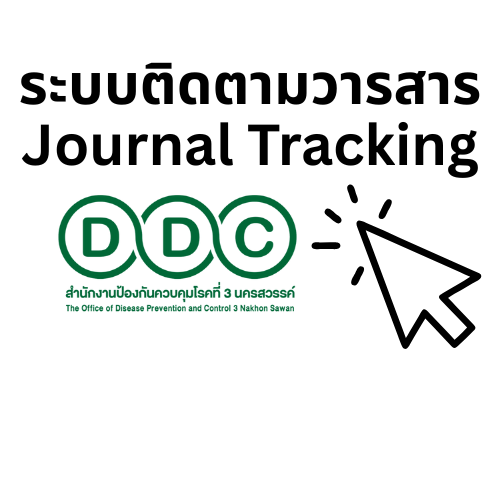การพยาบาลผู้ป่วยติดเชื้อเอชไอวีและซิฟิลิส: กรณีศึกษา
คำสำคัญ:
การพยาบาล, เอชไอวี, ซิฟิลิสบทคัดย่อ
การติดเชื้อเอชไอวีและซิฟิลิสเป็นปัญหาสำคัญทางสาธารณสุขทั่วโลก รวมถึงประเทศไทย โรคติดเชื้อทั้งสองส่งผลกระทบโดยตรงต่อคุณภาพชีวิตของผู้ป่วย ซึ่งจำเป็นต้องให้การพยาบาลและดูแลรักษาเพื่อให้ผู้ป่วยดำรงชีวิตอยู่ได้ในสังคม การศึกษานี้มีวัตถุประสงค์เพื่อศึกษาการนำกระบวนการพยาบาลมาใช้ในการพยาบาลผู้ป่วยติดเชื้อเอชไอวีร่วมกับซิฟิลิส โดยศึกษาผู้ป่วยติดเชื้อเอชไอวีและซิฟิลิส เพศชาย 1 ราย ใช้กระบวนการพยาบาลเป็นเครื่องมือในการศึกษา ระยะเวลาการศึกษาระหว่างเดือนมกราคม ถึง กุมภาพันธ์ 2565 ผลการให้การพยาบาลแบบองค์รวม พบว่า ผู้ป่วยมีภาวะสุขภาพที่ดีขึ้น 1)การรักษาพยาบาลด้านร่างกายช่วยลดอาการเจ็บป่วยทางกายและลดภาวะแทรกซ้อนของผู้ป่วย ผู้ป่วยมีการดูแลร่างกายได้ดี น้ำหนักเพิ่มขึ้น พักผ่อนเพียงพอ 2)การพยาบาลด้านจิตใจช่วยลดความเครียด คลายวิตกกังวล 3)การพยาบาลในด้านสังคมช่วยรักษาข้อมูลความลับสุขภาพของผู้ป่วย และช่วยผู้ป่วยปฏิบัติตนในการอยู่ในสังคมอย่างปกติสุข 4)การพยาบาลในด้านของจิตวิญญาณช่วยทำให้ผู้ป่วยยอมรับการติดเชื้อของตัวเอง ยอมรับการรักษา และปฏิบัติตนอย่างถูกต้องเหมาะสมเพื่อให้มีสุขภาพโดยรวมที่ดี ตลอดจนการป้องกันการแพร่เชื้อไปสู่บุคคลอื่น ดังนั้นการพยาบาลผู้ป่วยติดเชื้อเอชไอวีและซิฟิลิส จำเป็นอย่างยิ่งจะต้องใช้กระบวนการพยาบาลผู้ป่วยอย่างครอบคลุมในมิติต่างๆ ในทุกด้าน ได้แก่ ร่างกาย จิตใจ สังคม และจิตวิญญาณ เพื่อให้ผู้ป่วยได้รับการพยาบาลครบถ้วน สามารถดำรงชีวิตต่อไปได้อย่างปกติสุข
เอกสารอ้างอิง
World Health Organization. Global progress report on HIV, viral hepatitis, and sexually transmitted infections, 2021. Geneva: WHO; 2021.
กองโรคเอดส์และโรคติดต่อทางเพศสัมพันธ์. ศูนย์ข้อมูลสารสนเทศด้านเอชไอวีของประเทศไทย [อินเตอร์เน็ต]. [เข้าถึงเมื่อ 19 ก.พ. 2565]. เข้าถึงได้จาก: https://hivhub.ddc.moph.go.th/epidemic.php
ปิยนท วิรัชศิลป์, รวงผึ้ง สุทเธนทร์, จันทพงษ์ วะสี. New circulating recombinant rorms of HIV-1 in Thailand. วารสารโลหิตวิทยาและเวชศาสตร์บริการโลหิต 2550; 17(2): 169-79.
อชิรญาณ์ ปัทมะ. รังโรคของเชื้อเอชไอวีและความสำคัญของการตรวจวินิจฉัยทางห้องปฏิบัติการ. เวชบันทึกศิริราช 2560; 10(1): 18-22.
สำนักระบาดวิทยา. ระบบรายงานการเฝ้าระวังโรค 506 [อินเตอร์เน็ต]. [เข้าถึงเมื่อ 24 ก.พ. 2565]. เข้าถึงได้จาก: http://doe.moph.go.th/surdata/506wk/y64/d37_5164.pdf
คณิสร แก้วแดง, สุมาลี ราชนิยม. พยาบาลกับการดูแลผู้ป่วยเอดส์แบบองค์รวม. วารสารวิทยาลัยพยาบาลพระปกเกล้า จันทบุรี 2558; 26: 128-35.
กองโรคเอดส์และโรคติดต่อทางเพศสัมพันธ์ กรมควบคุมโรค. แนวทางการตรวจวินิจฉัยรักษาและป้องกันการติดเชื้อเอชไอวี ประเทศไทย ปี 2563/2564. กรุงเทพฯ: สำนักพิมพ์อักษรกราฟฟิคแอนด์ดีไซน์; 2563.
ยุทธชัย ไชยสิทธิ์, เสาวนีย์ โสบุญ. การเยียวยาผู้ติดเชื้อเอชไอวี/ผู้ป่วยเอดส์ที่มีภาวะบีบคั้นทางจิตวิญญาณ: บทบาทพยาบาล. วารสารการพยาบาลและการดูแลสุขภาพ 2560; 35(3): 31-8.
ศักดิ์ชัย ไชยมหาพฤกษ์, รสพร กิตติเยาวมาลย์. ซิฟิลิส: การกลับมาอีกครั้ง. วารสารควบคุมโรค 2564; 47(2): 199-208.
Solomon FB, Angore BN, Koyra HC, Tufa EG, Berheto TM, Admasu M. Spectrum of opportunistic infections and associated factors among people living with HIV/AIDS in the era of highly active anti-retroviral treatment in Dawro Zone hospital: a retrospective study. BMC Res Notes 2018; 11: 604.
ลัดดา พลพุทธา. การพยาบาลผู้ป่วยติดเชื้อเอชไอวี: กรณีศึกษา. วารสารโรงพยาบาลสกลนคร 2561; 21(1): 136-50.
ขนิษฐา สุขทอง. การพยาบาลผู้ป่วยเอดส์ที่มีโรคร่วมวัณโรคปอด: กรณีศึกษา. Singburi Hospital Journal 2564; 30(2): 95-108.
ดาวน์โหลด
เผยแพร่แล้ว
รูปแบบการอ้างอิง
ฉบับ
ประเภทบทความ
สัญญาอนุญาต
ลิขสิทธิ์ (c) 2022 วารสารโรคและภัยสุขภาพ สำนักงานป้องกันควบคุมโรคที่ 3 จังหวัดนครสวรรค์

อนุญาตภายใต้เงื่อนไข Creative Commons Attribution-NonCommercial-NoDerivatives 4.0 International License.
ประกาศเกี่ยวกับลิขสิทธิ์
|
บทความที่เผยแพร่ในวารสารโรคและภัยสุขภาพสำนักงานป้องกันควบคุมโรคที่ 3 จังหวัดนครสวรรค์ ถือว่าเป็นผลงานทางวิชาการหรือการวิจัย และวิเคราะห์ ตลอดจนเป็นความเห็นส่วนตัวของผู้เขียน ไม่ใช่ความเห็นของสำนักงานป้องกันควบคุมโรคที่ 3 จังหวัดนครสวรรค์ หรือกองบรรณาธิการแต่ประการใด ผู้เขียนต้องรับผิดชอบต่อบทความของตน |
นโยบายความเป็นส่วนตัว
|
ชื่อและที่อยู่ อีเมล์ ที่ระบุในวารสารโรคและภัยสุขภาพสำนักงานป้องกันควบคุมโรคที่ 3 จังหวัดนครสวรรค์ จะใช้เพื่อระบุตามวัตถุประสงค์ของวารสารเท่านั้น และจะไม่นำไปใช้สำหรับวัตถุประสงค์อื่น หรือต่อบุคคลอื่น |









